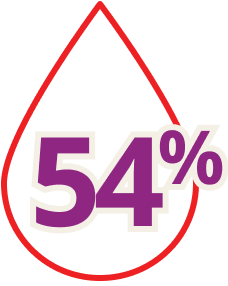Routine prophylaxis treatment in a prefilled, subcutaneous pen to prevent or reduce the frequency of bleeding episodes in adult and pediatric patients 12 years of age and older who have hemophilia B and A with or without inhibitors

Challenges persist in managing hemophilia B
From bleeds to difficult infusions to fluctuating factor levels, there continue to be unmet needs in hemophilia B (HB) treatment.1,2
What factors could be contributing to bleeds in your patients on FIX therapy?
Patients with HB can still experience bleeds
Up to 8 out of 10 patients
with HB on FIX reported experiencing at least 1 bleed within the previous 12 months1
81% of patients on SHL FIX (N=114) and 68% on EHL FIX (N=36) reported ≥1 bleed in the past year.1
Of the 150 patients, 33% received OD treatment and 67% received PPx.1
Real-world data collected in 2017 from the Adelphi Disease-Specific Programmes™ health record-based survey that includes combined data from United States and European hematologists and 150 patients with moderate to severe HB. Number of bleeding episodes is patient reported. Results may be limited due to mean ABR being numerically higher in patients in Europe. Due to non-interventional design, the study was subject to selection bias. Findings have not been confirmed by a clinical or randomized controlled trial.



(n=278)
of patients with HB had ≥1 target joint2,a
278 patients on SHL or EHL FIX treatment with 46% OD and 54% on PPx
aReal-world study collected data from 2015 patient records from the Cost of Hemophilia in Europe: a Socioeconomic Survey (CHESS)—a cross-sectional, retrospective analysis of adults with severe hemophilia (FVIII/FIX level <1 IU/dL) from France, Germany, Italy, Spain, and the UK. Non-interventional study design was subject to selection bias. Findings have not been confirmed by a clinical or randomized controlled trial. In CHESS, a target joint was defined as any joint with known chronic synovitis with additional criteria at the investigator's discretion. Commonly, a target joint is defined as a joint that experiences 3+ bleeds within a 6-month timeframe.2,3
Are your patients concerned about venous access issues?
Venous access and administration issues may be why patients with HB delay or avoid administering prophylaxis treatment4,5
Out of 65 Patients
40%
reported feeling worried at least sometimes about losing access to a vein due to their current factor treatment4,5
31%
reported physical discomfort during or after treatment administration at least sometimes4,5
Nearly
30%
reported experiencing blown or ruptured veins due to their treatment at least sometimes4,5
Data from an observational study including 112 patients with hemophilia B, from 2020 to 2022, were collected via an online survey which included the HEMO-TEM questionnaire with PicnicHealth. Patients responded to questions using a 5-point scale: never, rarely, sometimes, often, or always. Limitations may include selection bias due to the cross-sectional study design, variability in individual responses over time, does not account for continuous patient participation, and results have not been validated by clinical or randomized controlled trials.4,5
Patients may have poor venous access or need ports, which can increase risk of infection.6
Do your patients worry about the risk of bleeding during troughs?
Fluctuating factor levels due to peaks and troughs may cause uncertainty and worry3,7
As troughs near, bleed risk increases,6,7
Patients may purposely limit activities due to concerns about adequate bleed protection.8


(N=65)
~1 in 4 patients with HB
worried about adequate protection from bleeds due to their current treatment at least sometimes4,b
bData from an observational study including 112 patients with hemophilia B, from 2020 to 2022, were collected via an online survey with PicnicHealth. Patients responded to questions using a 5-point scale: never, rarely, sometimes, often, or always. Limitations may include selection bias due to the cross-sectional study design, variability in individual responses over time, does not account for continuous patient participation, and results have not been validated by clinical or randomized controlled trials4,5
Are there patients in your practice who may benefit from a change in therapy?
Models used for illustrative purposes only. These are hypothetical patient stories.

Mark and Melinda
Child and caregiver with venous access issues
Mark is a 13-year-old baseball player with severe hemophilia B. He and his mom, Melinda, are seeking a treatment option that Mark is able to administer himself.
Main concern:
- Venous Access
- “Infusion days are the worst days because Mark has small veins and has a phobia of needles.”
Current treatment:
EHL PPx (weekly)
Other treatment considerations:
- Infusion days are a dreaded challenge due to his severe anxiety about large needles
- Mom is concerned about long-term vein health and is interested in trying non-factor therapy
- Mark is looking for a treatment he can self-administer
- Concerned about bleed protection at the end of dosing cycles due to troughs

Sean
Young adult with breakthrough bleed concerns due to missed IV inusions
Sean is a 19-year-old with severe hemophilia B who struggles with IV administration and misses doses, which affects his bleed protection.
Main concern:
- Worries about bleeding due to inconsistent treatment.
- “I have a busy, active life so scheduling IV infusions is a challenge, especially when I have difficulty finding a vein.”
Current treatment:
EHL PPx (weekly)
Other treatment considerations:
- Would prefer a treatment that is not IV infused through a large needle
- Finds it a burden to travel with current treatment and supplies
- Ready to explore options that don’t require planning around peaks and troughs
- Seeking easy-to-use options that take less time to prepare and administer

Phillip
Older adult with scarred/
bruised veins
Phillip is a 58-year-old with moderate hemophilia B who struggles with infusions due to an elbow target joint.
Main concern:
- Venous health.
- “Because of my target joint in the elbow, I have difficulty moving my arm to self-infuse.”
Current treatment:
SHL on demand (possibly episodic)
Other treatment considerations:
- Limited venous access for infusions due to blown/scarred veins
- Would prefer prophylactic bleed protection that doesn’t require IV infusion
- Wants something backed by strong clinical safety data
- Seeking a treatment that can be administered despite limited mobility in his elbow
ABR=annualized bleeding rate; BPA=bypassing agent; HA=hemophilia A; HAwI=hemophilia A with inhibitors; HB=hemophilia B; HBwI=hemophilia B with inhibitors; IV=intravenous.
Important Safety Information for Alhemo®
Contraindications
- Alhemo® is contraindicated in patients with a history of known serious hypersensitivity to Alhemo® or its ingredients
Warnings and Precautions
- Thromboembolic Events (TEs): Venous and arterial TEs were reported in 1.9% of patients (6/320) who also had multiple risk factors, including the use of high doses or prolonged treatment with factor product or bypassing agent (2 of 6 patients). Risk factors for TEs may also include conditions in which tissue factor is overexpressed (eg, atherosclerotic disease, crush injury, cancer, disseminated intravascular coagulation, thrombotic microangiopathy, or septicemia). Inform patients about and monitor them for signs and symptoms of TEs. In case of suspicion of TEs, discontinue Alhemo® and initiate further investigations and management strategies
- Hypersensitivity Reactions: Alhemo® is contraindicated in patients with a history of known serious hypersensitivity to Alhemo® or its ingredients. Hypersensitivity reactions, including erythema, rash, pruritus, and abdominal pain, have occurred in patients treated with Alhemo®. One patient (<1%) experienced anaphylaxis, which resolved after treatment with antihistamines and corticosteroids. Instruct patients of the signs of acute hypersensitivity reactions and to contact their healthcare provider for mild reactions and to seek urgent medical attention for moderate to severe reactions. Discontinue Alhemo® if severe hypersensitivity symptoms occur and initiate medical management
- Increased Laboratory Values of Fibrin D-dimer and Prothrombin Fragment 1.2: Increased levels of fibrin D-dimer and prothrombin fragment 1.2 were seen in 29 (9.1%) and 26 (8.1%) patients, respectively, which is positively correlated with the plasma concentration of concizumab-mtci, indicating a hemostatic effect. For patients taking Alhemo®, these coagulation biomarkers may not be reliable predictive markers for clinical decision-making with suspicion of thrombosis, such as deep vein thrombosis and pulmonary embolism
Adverse Reactions
- The most frequently reported adverse reactions (≥5%) were injection site reactions, headache, and urticaria
- Serious adverse reactions were reported in 6.1% of patients with inhibitors who received Alhemo®. Permanent discontinuation of Alhemo® occurred in 1 patient due to a renal infarct and dosage interruptions of Alhemo® occurred in 1 patient (3%) and was a hypersensitivity reaction
Drug Interactions
- Breakthrough Bleeding Treatment: Take appropriate precautions when treating breakthrough bleeding events in patients receiving Alhemo® prophylaxis and FVIII or FIX or a bypassing agent (eg, rFVIIa or aPCC). For mild and moderate bleeds, the lowest approved dose in the approved product labeling is recommended. For aPCC, a maximum dose of 100 units/kg within 24 hours is recommended. For severe bleeds, follow the dosing instructions in the approved labeling based on clinical judgment
Please click here for Alhemo® Prescribing Information.
Indications and Usage
Alhemo® (concizumab-mtci) injection 60 mg, 150 mg, or 300 mg is indicated for routine prophylaxis to prevent or reduce the frequency of bleeding episodes in adult and pediatric patients 12 years of age and older with hemophilia A or B with or without Factor VIII or IX inhibitors.
Important Safety Information for Alhemo®
Contraindications
- Alhemo® is contraindicated in patients with a history of known serious hypersensitivity to Alhemo® or its ingredients
Warnings and Precautions
- Thromboembolic Events (TEs): Venous and arterial TEs were reported in 1.9% of patients (6/320) who also had multiple risk factors, including the use of high doses or prolonged treatment with factor product or bypassing agent (2 of 6 patients). Risk factors for TEs may also include conditions in which tissue factor is overexpressed (eg, atherosclerotic disease, crush injury, cancer, disseminated intravascular coagulation, thrombotic microangiopathy, or septicemia). Inform patients about and monitor them for signs and symptoms of TEs. In case of suspicion of TEs, discontinue Alhemo® and initiate further investigations and management strategies
- Hypersensitivity Reactions: Alhemo® is contraindicated in patients with a history of known serious hypersensitivity to Alhemo® or its ingredients. Hypersensitivity reactions, including erythema, rash, pruritus, and abdominal pain, have occurred in patients treated with Alhemo®. One patient (<1%) experienced anaphylaxis, which resolved after treatment with antihistamines and corticosteroids. Instruct patients of the signs of acute hypersensitivity reactions and to contact their healthcare provider for mild reactions and to seek urgent medical attention for moderate to severe reactions. Discontinue Alhemo® if severe hypersensitivity symptoms occur and initiate medical management
- Increased Laboratory Values of Fibrin D-dimer and Prothrombin Fragment 1.2: Increased levels of fibrin D-dimer and prothrombin fragment 1.2 were seen in 29 (9.1%) and 26 (8.1%) patients, respectively, which is positively correlated with the plasma concentration of concizumab-mtci, indicating a hemostatic effect. For patients taking Alhemo®, these coagulation biomarkers may not be reliable predictive markers for clinical decision-making with suspicion of thrombosis, such as deep vein thrombosis and pulmonary embolism
Adverse Reactions
- The most frequently reported adverse reactions (≥5%) were injection site reactions, headache, and urticaria
- Serious adverse reactions were reported in 6.1% of patients with inhibitors who received Alhemo®. Permanent discontinuation of Alhemo® occurred in 1 patient due to a renal infarct and dosage interruptions of Alhemo® occurred in 1 patient (3%) and was a hypersensitivity reaction
Drug Interactions
- Breakthrough Bleeding Treatment: Take appropriate precautions when treating breakthrough bleeding events in patients receiving Alhemo® prophylaxis and FVIII or FIX or a bypassing agent (eg, rFVIIa or aPCC). For mild and moderate bleeds, the lowest approved dose in the approved product labeling is recommended. For aPCC, a maximum dose of 100 units/kg within 24 hours is recommended. For severe bleeds, follow the dosing instructions in the approved labeling based on clinical judgment
Please click here for Alhemo® Prescribing Information.
Indications and Usage
Alhemo® (concizumab-mtci) injection 60 mg, 150 mg, or 300 mg is indicated for routine prophylaxis to prevent or reduce the frequency of bleeding episodes in adult and pediatric patients 12 years of age and older with hemophilia A or B with or without Factor VIII or IX inhibitors.
References:
- Chhabra A, Spurden D, Fogarty PF, et al. Real-world outcomes associated with standard half-life and extended half-life factor replacement products for treatment of haemophilia A and B. Blood Coagul Fibrinolysis 2020;31 (3):186-192.
- Booth J, Oladapo A, Walsh S, et al. Real-world comparative analysis of bleeding complications and health-related quality of life in patients with haemophilia A and haemophilia B. Haemophilia. 2018;24(5):e322- e327.
- Srivastava A, Santagostino E, Dougall A, et al. WFH guidelines for the management of hemophilia. Haemophilia. 2020;26(suppl 6):1-158.
- Data on file. Novo Nordisk Inc.
- Wheeler AP, Cibelli E, Hanson G et al. Treatment and disease burden in a cohort of people with haemophilia without inhibitors in the United States. Haemophilia. 2025:e70078.
- Brod M, Bushnell DM, Neergaard JS, Waldman LT, Busk AK. Understanding treatment burden in hemophilia: development and validation of the Hemophilia Treatment Experience Measure (Hemo-TEM). J Patient Rep Outcomes. 2023;7(1 ):17.
- Role of new prolonged half-life clotting factors in hemophilia. NBDF. National Bleeding Disorders Foundation. Accessed September 3, 2025. https://www.bleeding.org/sites/default/files/document/files/phlbrochure.pdf
- Baumann K, Hernandez G, Witkop M, et al. Impact of mild to severe hemophilia on engagement in recreational activities by US men, women, and children with hemophilia B: the Bridging Hemophilia B Experiences, Results and Opportunities into Solutions (B-HERO-S) study. Eur J Haematol. 2017;98 Suppl 86:25-34.
